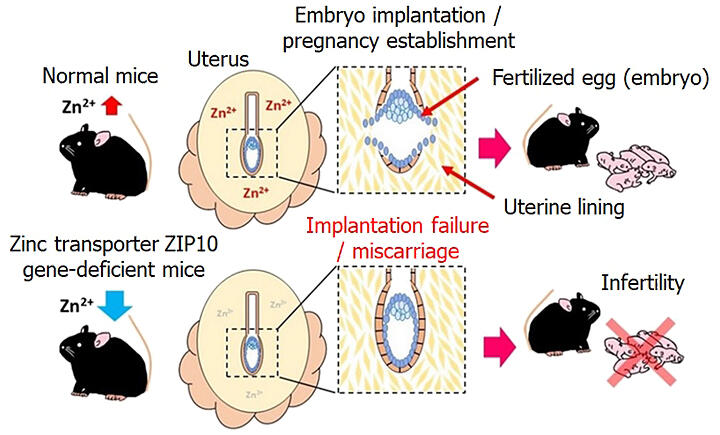A research group from Azabu University has revealed through studies with mice that zinc deficiency can lead to infertility by preventing fertilized eggs from implanting in the uterus. The causes of implantation failure, a type of infertility, were unknown until now, and repeated in vitro fertilization attempts are often required in both humans and livestock, creating significant burden. Modern people are said to be zinc deficient, suggesting that those hoping to become pregnant may need to supplement their zinc intake.
Human pregnancy begins with implantation, when a fertilized egg divides repeatedly to become a blastocyst that reaches the uterine lining, breaks down part of the epithelium, and embeds itself into the endometrium. Once embedded in the endometrium, the fertilized egg exchanges oxygen and nutrients with the womb and eventually develops into a fetus. Mice undergo pregnancy through almost the same mechanism.
Professor Junya Ito, who studies animal reproduction and molecular reproductive science, and Lecturer Jumpei Terakawa, who focuses on comparative animal pathology and laboratory animal science, from Azabu University's School of Veterinary Medicine and their research group have been studying the effects of zinc on pregnancy and childbirth. In this study, they focused on the uterus to determine at which stage of pregnancy zinc is involved. They observed mice divided into two groups: one where the ZIP10 gene, which transports zinc to the uterine lining, functioned normally, and another where ZIP10 was made non-functional through gene deletion.
The results showed that in the group where ZIP10 functioned normally, part of the epithelium of the uterine lining broke down, allowing the fertilized egg to embed itself over time, with fetuses visible in the uterus by day 10 of pregnancy. However, in the group where ZIP10 did not function, the epithelium did not break down, preventing the fertilized egg from properly embedding in the endometrium, leading to implantation failure. This means that pregnancy cannot be established even when transferring high-quality fertilized eggs through in vitro fertilization.

Provided by Azabu University
Additionally, the study revealed that in the group where ZIP10 did not function, the effect of progesterone—a female hormone essential for establishing and maintaining pregnancy—was weakened, explaining the failure to implant. Furthermore, the same results were obtained using cultured cells derived from human uterine lining, suggesting that similar situations occur in human infertility cases.
The Ministry of Health, Labour and Welfare recommends a daily zinc intake of 11 milligrams for adult men and 8 milligrams for women. However, many people have insufficient zinc levels due to unbalanced diets and stress. Even if these amounts are consumed, side effects from medications for conditions like diabetes can cause excessive zinc excretion, leading to zinc deficiency. Excess zinc beyond the recommended amount is reportedly excreted in feces.
Ito commented, "I'm glad we discovered why zinc is necessary for mothers. If zinc intake can prevent infertility, taking supplements could lead to higher pregnancy rates during in vitro fertilization. I think this is good news for people struggling with infertility where fertilized eggs are obtained but pregnancy isn't established."
The research was conducted jointly with Tokushima Bunri University, with funding from the Japan Society for the Promotion of Science's Grants-in-Aid for Scientific Research, the Ministry of Education, Culture, Sports, Science and Technology's Private University Branding Project, and the Azabu University Center for Human and Animal Symbiosis Science. The findings were published in PNAS Nexus on February 10 and announced by Azabu University on February 18.
Original article was provided by the Science Portal and has been translated by Science Japan.




